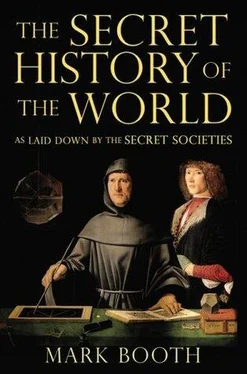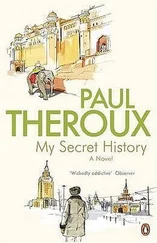The story of Rama also brings us back to the notion that according to the secret history the cosmos has been formed in order to create the conditions in which people could experience free thought and free will. Rama could have enforced what is good and right on his people by ruling them with a rod of iron, but he instead let them decide for themselves. Rama is thus the archetype of the exiled or ‘Secret King’ or ‘Secret Philosopher’ who influences the course of history not from the throne but by mingling incognito among the people. Rama tried to help humans to evolve freely.
Rama is a demi-god, but declines to be ruler of the world. No longer will gods or even demi-gods sit on thrones in bodies of flesh and bone.
AT JOURNEY’S END THE EMIGRANTS FOUNDED Shambala, a great spiritual fortress in the mountainous region of Tibet. The roof of the world, Tibet is the world’s biggest, highest plateau surrounded by high mountain ranges. Some traditions say the Tibetan population is directly descended from the people of Atlantis.
Some say that Shambala can only be reached via an underground tunnel, others that it exists in another dimension into which a secret portal opens somewhere in the region. St Augustine was the greatest Christian theologian after St Paul and, like St Paul, was an initiate of a Mystery school. He wrote about the place where Enoch and the saints lived, a terrestrial paradise so high up that the Flood could not reach it. Emmanuel Swedenborg, the eighteenth-century Swedish theologian, diplomat and inventor — and also the leading esoteric Freemason of the age — wrote that ‘the “Lost Word” must be sought among the sages of Tibet and Tartary’. Anne-Catherine Emmerich, the nineteenth-century German Catholic mystic wrote similarly of a Mount of Prophets where live Enoch, Elijah and others who did not die in the ordinary way but ‘ascended’, and where unicorns which survived the Flood may also be found.
From the mountain fastnesses of Tibet flowed streams of living spirituality which joined together, gathered force, depth and width and became a mighty river like the Ganges, feeding the whole of India.
IN THIS HISTORY OF THE WORLD WRITTEN in the stars, the next era began as the sun began to rise in the constellation of Cancer in 7227 BC and the first great Indian civilization, the earliest and most deeply spiritual of post-Flood civilizations, was founded. The founders felt little for the newly created material world, which they saw as ‘maya’, an illusion threatening to obscure the higher realities of the spirit worlds. They looked back with nostalgia to the time before this veil of matter had been drawn between humankind and the spiritual hierarchies.
The icy baths and other forms of self-torture of the ascetics can be looked on as part of the effort to stay awake to the spirit worlds. A conscious effort was made by them, while the veil was still relatively translucent, to remember the lineaments of the spirit world, and to impress them indelibly on human consciousness.
The success of this enterprise has meant that India is still the world’s greatest storehouse of spiritual knowledge, particularly as regards occult physiology. As a high level initiate recently said to me, ‘If you visit India today, you cannot help feeling how the air still just crackles with astrality.’
Great Western teachers such as Pythagoras, Apollonius of Tyana and St Germain have travelled to India in search of this astrality. The Gospels contain quotes from older, Indian sources and more ideas that originated there.
Sir John Woodruffe, the Sanskrit scholar who first translated the tantric texts in the nineteenth century, has written how even the venerable Sufi tradition leant on Hindu wisdom for teachings on the chakras, for example.
In the 1960s onwards, Indian religion was felt by many people in the West to offer a working spiritual knowledge, including practical spiritual disciplines and guides through the spirit worlds, which they could not find in church. A bookshop in the West is still likely to stock more books on mysticism derived from the Eastern than from the Western tradition.
FOLLOWING RAMA’S REFUSAL TO TAKE THE crown, no great single personality dominates this period. If Rama was an all-action hero who fought monsters, went on long, dangerous adventures and founded cities, his successors, sometimes called the Seven Wise Ones, or the Rishis, had a stillness, an inactivity about them. They built no stone buildings. They lived in buildings of mud or simple shelters twisted into shape from roots and tendrils. Nothing of the Rishis has lasted except what they knew.
There is a simple saying in the Cabala: ‘Everything you have seen, every flower, every bird, every rock will pass away and turn to dust, but that you have seen them will not pass away.’ This is a saying that would have seemed sympathetic to the Rishis. Seated with legs folded so that the soles of their feet turned upwards, they had no desire to feel gravity, the downward, reductive pull of the material world, but headed instead for the spirit worlds. They were able to see spiritual beings at work on the earth, how they help seeds to germinate in spring, flowers to blossom in summer, trees to bear fruit in autumn — and how seeds are preserved through winter by these same spiritual beings. The Rishis experienced the ebb and flow of spiritual influence like a giant breath. Ancient Indian civilization was like the lowest realm of Heaven.
Earlier we talked about the way materialists misappropriate words and phrases such as ‘the meaning of life’, using them in a secondary and slightly dishonest sense. The same is true of ‘spiritual’, often used by people to puff themselves as good-hearted or moral in a warm, fuzzy, perhaps pseudo-mystical way. What it really means is the ability to see, hear and communicate with the spirits like the Indian adepts.
They were also able to communicate in occult ways. Other people were felt by them to be sympathetic or not by their breathing. By breathing in someone else’s air, they could sense that person’s inner life.
Adepts were able to pour their knowledge into the souls of others in an unceasing flow of pictures. Much later this knowledge would be put into words and passed from generation to generation orally until it was finally written down as the Vedas .
Their gaze could drive away serpents and calm lions and tigers. Nothing could deflect the adepts from their contemplation. They wandered freely, building only the flimsiest shelters, eating fruit and drinking the milk of their flocks. They would eat only vegetable matter, never any meat. To do so, they believed, was to absorb the animal’s death agony.
They immersed themselves in vegetable consciousness, in the physical processes — waking, sleeping, breathing, digesting — which we have seen are the gift of the vegetable kingdom to the human body. By learning to control the ens vegetalis , or etheric body, they could control, too, breathing, the rate of digestion, even heart rate and the flow of blood, leading to the amazing feats for which Indian adepts are famous — the ability to stop the heart altogether just by thinking about it, for example.
The adepts understood, too, how sinking deep into contemplation of the solar plexus chakra enabled them to perceive clairvoyantly. And they knew how to wrap others in a protective beam of love emanating from the heart chakra.
In addition to the sixteen petals of the heart chakra, the adepts saw 101 subtle and luminous arteries issuing from the same area like spokes from a wheel. Three of these, larger ones they saw rising to the head. One rises to the right eye and corresponds to the sun and the future. Another rises to the left eye and corresponds to the moon and the past. They understood how it was by a combination of these two organs that humans are enabled to perceive the movements of material objects in relation to one another in space and so also to have a sense of time passing.
Читать дальше












